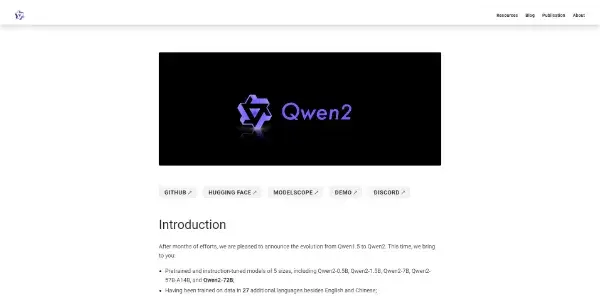Qwen2

A new language model with up to 72 billion parameters. Trained on 27 languages, this LLM excels in coding and mathematics. Available as open source
Qwen-2: A Powerful Open-Source Large Language Model
Qwen-2 is a newly released large language model (LLM) boasting up to 72 billion parameters. This impressive scale, coupled with its multilingual training across 27 languages, positions Qwen-2 as a significant contender in the rapidly evolving field of AI. Crucially, it's offered as open-source, fostering collaboration and innovation within the AI community.
What Qwen-2 Does
Qwen-2 excels at various natural language processing tasks, including text generation, translation, question answering, and code generation. Its strength lies particularly in its proficiency with coding and mathematical problem-solving, making it a valuable tool for developers and researchers alike. The model processes input text and generates coherent, contextually relevant outputs, demonstrating a high degree of understanding and fluency.
Main Features and Benefits
- Massive Parameter Scale: With up to 72 billion parameters, Qwen-2 demonstrates a significant capacity for complex understanding and nuanced output. This translates to higher accuracy and more sophisticated reasoning capabilities compared to smaller models.
- Multilingual Support: Trained on 27 languages, Qwen-2 offers superior multilingual capabilities, enabling applications in diverse global contexts. This broad linguistic coverage opens up opportunities for cross-cultural communication and information access.
- Coding Proficiency: Qwen-2 demonstrates strong coding skills, capable of generating, debugging, and explaining code across multiple programming languages. This feature is invaluable for developers seeking assistance with coding tasks or exploring novel solutions.
- Mathematical Abilities: The model exhibits advanced mathematical capabilities, enabling it to solve complex problems and handle numerical reasoning tasks effectively. This strength is particularly beneficial for scientific research, data analysis, and educational applications.
- Open-Source Availability: The open-source nature of Qwen-2 encourages community contributions, fosters transparency, and promotes wider accessibility. This allows developers to modify, improve, and adapt the model to their specific needs.
Use Cases and Applications
The versatility of Qwen-2 makes it applicable across numerous fields:
- Software Development: Assisting developers with code generation, debugging, and documentation.
- Education: Providing personalized learning experiences, answering student questions, and generating educational content.
- Research: Facilitating scientific research through data analysis, hypothesis generation, and literature review.
- Customer Service: Powering chatbots and virtual assistants capable of handling complex customer inquiries in multiple languages.
- Content Creation: Generating various forms of content, including articles, summaries, and creative writing pieces.
- Translation Services: Providing accurate and efficient translation services across a wide range of languages.
Comparison to Similar Tools
Qwen-2 distinguishes itself from similar LLMs through a combination of factors: its substantial parameter count, strong multilingual support, specific focus on coding and mathematics, and most importantly, its open-source nature. While other LLMs may excel in specific areas, Qwen-2 offers a balanced and powerful combination of capabilities, freely available for customization and adaptation. Direct comparisons to specific models (e.g., GPT-4, LLaMA) require benchmark testing on specific tasks, but the open-source nature of Qwen-2 allows for such comparative analysis to be readily conducted by the research community.
Pricing Information
Qwen-2 is completely free to use. Its open-source license allows for unrestricted access and usage, promoting widespread adoption and collaboration. This open access significantly lowers the barrier to entry for researchers and developers, fostering innovation in the field of large language models.